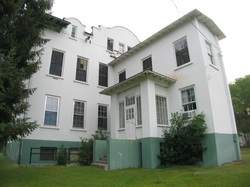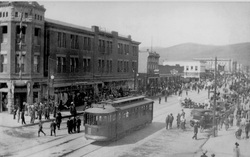2008 Eleven Most Endangered Historic Sites
1. Missoula County Fairgrounds Buildings
Controversies about the use of fairgrounds property and proposed master plans calling for new construction on the property threaten the historic fairgrounds buildings that represent our quickly disappearing agricultural heritage. Preserve Historic Missoula has been influential in alerting the public and encouraging a closer look at fairgrounds development. Continued monitoring of the situation will help insure that the public’s interests in these buildings are represented.
2. Bonner Mill Housing District

Historic house in Bonner, millworkers house.
The partnership represented by the Bonner Mill was extremely important to the early industrialization and economic development of Missoula and Western Montana. Until recently, the company housing built to accommodate workers at the Bonner Mill was fairly intact, with good physical integrity. The property was recently sold to a developer who has indicated he would like the district listed in the National Register of Historic Places. That attention to historic preservation could help to preserve these houses that are so significant to the area’s history; however, some of the buildings will need to be moved and their relocation may affect their integrity as historic resources. PHM can provide assistance in working through issues relating to nomination and preservation of these buildings.
3. Bonita Ranger Station
The Bonita Ranger Station consists of buildings on fifteen acres of land and is located in the Missoula District, Lolo National Forest, north of I-90 and east of the Rock Creek interchange. The property was determined eligible for listing in the National Register of Historic Places in 1990. The Missoula Ranger District has vacated the remaining buildings at Bonita in anticipation of selling the property under the FS building conveyance authority. Its location near the new Ridge Above Rock Creek subdivision makes it likely that the property will be sold to a developer and the historical buildings and open space will be lost. PHM can urge that any sale of the property carry historical covenants that include preservation of the extant historic buildings, as well as a limitation on the number and character of additional buildings that could be built on the property.
4. Historic Missoula Public School Buildings
Historic Missoula Public School Buildings reflect the establishment of public school education in the community and the development of Missoula’s educational system in the 20th Century. A survey of public school buildings conducted in the late 1990s confirmed the presence of significant school buildings and reflected the community’s interest in them. Modern space and technological requirements, changing population patterns, and development pressures endanger the preservation of these important parts of our history. PHM can encourage rehabilitation of buildings for educational use as well as urge deed restrictions on school building sales to prevent their demolition or their conversion to properties that do not reflect their historical significance. Significant school buildings include:
|
|
5. Original Loyola High School Building; original St. Francis Xavier (St. Joseph's School
These two school buildings represent important components of education in Missoula. Both buildings have good integrity and comprise part of the “Catholic Block” that represent neighborhood religious activity, but are threatened by area development pressures and deterioration. PHM can encourage preservation and rehabilitation of these buildings to ensure that they remain viable components of the neighborhood.
6. Lolo Trail NHL
The Lolo Trail, a National Historic Landmark, is an ancient travel route across the Bitterroot Mountains, used by Native Americans to access buffalo hunting grounds and salmon fisheries, by Lewis and Clark and the Corps of Discovery to cross the mountains, and by the Nez Perce in their attempt to flee to Canada in the 1877 Nez Perce War. From Graves Creek east to Travelers Rest, the Lolo Trail National Historic Landmark is in danger of being obliterated by private subdivisions. Land ownership is divided between Plum Creek and a number of small private landowners. PHM can encourage easements or outright sale of segments of the trail to the USFS, which would administer the property as a historic resource.
7. Alder Street Railroad Worker's Housing
These small houses on tiny lots in close proximity to the Pine Street mansions speak to a history of class integration within one of Missoula’s first neighborhoods In general, preservation of mansions is more widely supported than preservation of workers’ housing; yet, workers’ housing is equally significant to the economic and social history of any community. With the increasing attractiveness of downtown residential housing, the small houses are subject to tear-down or insensitive renovation. PHM can encourage the preservation of these houses and their use as affordable housing units or sites for small businesses.
8. 600 University Avenue (The Tremper House)
The present home of the University of Montana’s Native American Studies—and the last house remaining on the block—retains high architectural and structural integrity, but is in danger of demolition after the program moves to a new building. PHM can encourage reuse rather than demolition of the property for parking or some other function.
9. Post Hospital, Building T-9, Fort Missoula

Hospital at Fort Missoula.
The Post Hospital, constructed in 1911, is a 3 ½ story building and one of the superlative examples of Mission-style architecture at Fort Missoula. The hospital served as the main medical facility at the fort and is a contributing resource to the Fort Missoula Historic District, which was listed on the National Register of Historic Places in 1987. The Post Hospital is currently owned and used by the Western Montana Mental Health Center. The WMMHC is committed to rehabilitating and preserving this historic building, but the financial implications threaten that preservation. PHM can encourage the community’s support in saving this important building.
10. Lincoln School
The Lincoln School property, listed in the National Register of Historic Places in 1997, represents a significant community landmark as well as an important component in the history of Missoula’s educational system. Current development plans indicate the loss of open space around the school and its conversion to a peripheral building in a housing development. PHM can encourage sensitive treatment of the property.
11. Missoula's Historic Districts

View of downtown Missoula, Higgins Avenue.
All of Missoula's historic districts and proposed historic districts that do not have any regulatory historic district guidelines. The lack of guidelines highlight the problems inherent with new construction in historic districts and the need for zoning codes that require sympathetic treatment of historic districts. The City of Missoula zoning codes are currently being revised. Preserve Historic Missoula will encourage the development of appropriate zoning for our historic districts.
